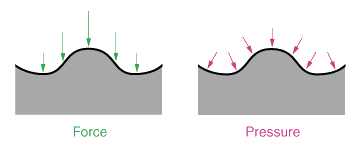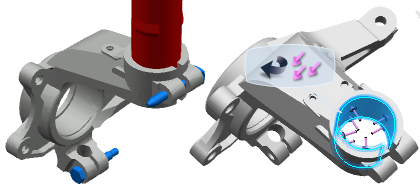About Pressures | ||||
|
| |||
Click Play to watch the video:
A pressure definition consists of two components:
- the transmission surface (defined by the selected part face); and
- a specified magnitude.
The pressure magnitude is specified in units of force per area; this magnitude is applied normal to the transmission surface at every point on the surface. Unlike a force, which always acts in a single direction, a pressure is applied normal to all regions of a surface during the entire simulation, regardless of the surface curvature.
Pressures typically represent the forces exerted by a gas on the walls of a container, such as air in a balloon. However, a pressure load can also be used to model the contact forces between two closely fitting, conforming parts. In the example below, the shaft diameter is slightly larger than the diameter of the encircling flange hole, resulting in an even force around the perimeter of the interior flange surface; a pressure load effectively approximates this force.